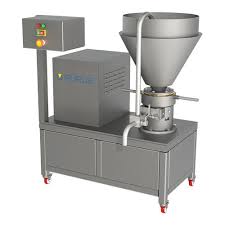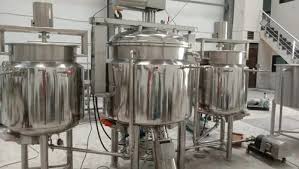|
Getting your Trinity Audio player ready... |
Main Components of a Tube Filler Machine and Their Functions part 2
Tube Filler A tube filling machine consists of several key components, each playing a crucial role in ensuring the proper operation of the machine. The design of every part is purposeful, and each component has a specific function to ensure the efficient filling of tubes with various substances like creams, gels, and liquids. Below is a detailed exploration of the main components that make up a tube filler machine and how they contribute to its functionality.
1. Frame
The frame serves as the structural foundation of the tube filling machine. All the other components of the machine are mounted on this frame, which gives the entire system its shape and support. The frame is typically constructed from durable materials that are resistant to wear and tear, corrosion, and extreme weather conditions. Its robust design ensures that the tube filling machine remains stable during operation, supporting the weight and function of other components like pumps, tanks, and nozzles. Stainless steel is often used for frames due to its strength and resistance to corrosion, making it an ideal choice for industries that involve handling liquids and pasty products.
2. Tank: Tube Filler
The tank is the component of the tube filling machine where the product intended for filling is stored before being dispensed into the tubes. It is positioned at an elevated height to facilitate the easy flow of the material into the tubes due to gravity. Some tube filling machines come with a single tank, while others are equipped with multiple tanks to accommodate different products. The number of tanks typically depends on the machine’s design and the production capacity. These tanks are usually made of stainless steel because the material is non-reactive and resistant to the varying temperatures and conditions in the production environment. Proper tank design is essential, as it ensures the product stays safe from contamination and retains its quality.
3. Filling Nozzle
The filling nozzle plays a vital role in directing the product from the tank into the tubes. It controls the flow and ensures that the product is dispensed accurately and evenly. The nozzle is usually connected to the product supply system using a tri-clover connection, which ensures a secure and leak-proof attachment. Different types of nozzles are designed for specific applications, such as for viscous liquids or those with low surface tension. When filling large volumes, the nozzle size needs to be appropriately matched to avoid overfilling or spilling. It is important that nozzles are designed to prevent dripping, as excess product waste can reduce efficiency and increase operational costs.
4. Coding Jaws
The coding jaws are used to apply a printed code or batch number onto the tube after it has been filled and sealed. These jaws are adjustable to accommodate different tube sizes and materials, ensuring that they function well with tubes of varying thicknesses or hardness. The coding jaws help in the final steps of preparing the tube for delivery to customers, ensuring that the product information is clearly visible. This feature is essential for compliance with industry regulations and product traceability.
5. Dosing Pump
A dosing pump is responsible for accurately measuring and dispensing the product into the tubes. This type of pump is often a displacement pump, which ensures a consistent product flow rate. The dosing pump draws a specified amount of product into its chamber and then injects it into the dosing tank, from where it is later dispensed into the tubes. The pump is typically powered by an electric motor, which allows for precise control over the product’s flow during the filling process. Adjustments can be made to control the pump’s output, ensuring that the correct volume of product is filled into each tube.
6. Control Unit
The control unit is the brain of the tube filling machine, where the operator sets the parameters for operation. This component allows the user to configure settings such as filling speed, product quantity, and other operational aspects of the machine. Modern tube filling machines come with advanced touch-screen interfaces, making them easier to operate. The control unit ensures that all settings are programmed correctly before the machine starts running, ensuring consistent and high-quality results throughout the production process. Proper operation of the control unit is essential for maintaining product quality and preventing errors during filling.
7. Discharge Unit
The discharge unit is responsible for regulating the flow of the product from the tank into the tubes. This component ensures that the correct amount of product is dispensed into each tube during the filling process. The discharge unit often allows for adjustments to meet varying requirements in product quantity. It is a crucial part of the tube filling machine because accurate product measurement is critical for maintaining the desired product specifications and quality standards.
8. Tube Holder
The tube holder is designed to securely hold the tubes in place during the filling process. As the tubes pass through the various stations in the tube filling machine, they are rotated and aligned to ensure uniform filling. The tube holders are typically made to accommodate a large number of tubes at once, and their capacity is determined by the machine’s overall design. These holders rotate at high speeds to keep up with the filling and sealing processes, ensuring smooth operation. Automatic tube holders help reduce manual labor and improve the efficiency of the filling process by eliminating the need for human intervention.
9. Hopper
A hopper is a funnel-like component that is used to transfer product from one container to another. The hopper is typically positioned at the top of the machine to facilitate the smooth movement of the product into the filling system. It can be adjusted to different angles by the operator, allowing for optimal product flow and ease of operation. The hopper’s size depends on the machine’s design and capacity and plays a crucial role in maintaining the efficiency of the filling process.
10. Electronic Box
The electronic box is the component that houses all the electronic connections required for the proper functioning of the tube filling machine. This box is made up of several essential elements, including:
- Air Switch: Protects the machine’s circuit from electrical surges.
- Relay: Controls the wiring of the Variable Frequency Drive (VFD) board.
- Wiring Board: Connects all the cables to the Programmable Logic Controller (PLC), ensuring proper operation.
- Transformer: Helps to regulate electrical power.
- Drive and Solenoid Valve: These components manage the machine’s motor and product flow system.
11. Motor
The motor is the component that converts electrical energy into mechanical energy, driving the machine’s various parts. The motor is responsible for powering the tube filling machine and enabling it to operate efficiently. Depending on the machine’s size and workload, the motor’s capacity will vary. For machines that handle heavier workloads, larger motors are needed to provide the necessary power for smooth operation.
12. Safety System
The safety system is designed to protect the machine operator from potential hazards during operation. This system includes emergency stop buttons and other safety features that can be activated in case of an emergency. The safety system helps prevent accidents and reduces the risk of equipment damage, ensuring that the machine remains operational without risking human safety.
Working Principle of Tube Filling Machines
The operation of a tube filling machine begins by placing the tubes onto the tube holder, either manually or automatically, depending on the type of machine. Once the tubes are in place, the operator sets all necessary parameters using the control unit, including speed, product quantity, and other relevant settings. After the machine is powered on, the tube holder begins to rotate, moving the tubes through various workstations, where they undergo a series of steps: filling, sealing, coding, and cutting.
The entire process is automated, ensuring that the product is consistently filled and sealed in the tubes. The operator’s role is mainly supervisory, ensuring that the machine operates smoothly and that the set parameters are adhered to.
Materials Used in Tube Filling Machines
Tube filling machines are typically made from materials that are resistant to water, heat, and corrosion. Stainless steel, particularly SS 316, is commonly used for the parts that come into direct contact with the product. This material is known for its durability, ease of cleaning, and resistance to rust and corrosion, making it ideal for use in industries such as pharmaceuticals, food, and cosmetics.
Specifications and Models of Tube Filling Machines
Each tube filling machine has a set of technical specifications that define its performance and capabilities. These include production speed, power requirements, and the volume of the tubes that can be filled. The specifications for different models can vary, with machines available for small, medium, and large-scale production runs. Some common specifications include power consumption (measured in kilowatts), air volume, and tube diameter.
Comparison Between Automatic and Semi-Automatic Tube Fillers
Both automatic and semi-automatic tube filling machines are used for filling and sealing a wide range of products. However, they differ in terms of automation, cost, and production capacity. Semi-automatic machines require manual loading of tubes, while automatic machines can load tubes automatically. Automatic machines are more suitable for large-scale production, while semi-automatic machines are often used for smaller batches.
Troubleshooting Common Tube Filling Machine Issues
Problems such as inconsistent filling, leaks, or malfunctioning components can disrupt the tube filling process. Common issues include improperly leveled machines, short pump durations, or worn-out parts. Identifying and addressing these issues early can help maintain consistent filling quality and ensure the machine operates efficiently.
Rotary Tube Filler Machines
A rotary tube filler machine is used for high-speed production of plastic and aluminum tubes. It is commonly employed in the food, chemical, pharmaceutical, and cosmetics industries and comes in various configurations, including automatic and semi-automatic models.
Loading Products into the Tube Filling Machine
Depending on whether the machine is semi-automatic or fully automatic, loading products can be done manually or automatically. In fully automated systems, products are loaded through a material conveyor, streamlining the process and reducing the need for manual intervention.
In conclusion, a tube filling machine is a complex piece of equipment that involves several components working together to ensure the accurate and efficient filling of tubes. Understanding the roles of each component and maintaining the machine properly is essential for achieving high-quality production and minimizing downtime










Leave a Reply